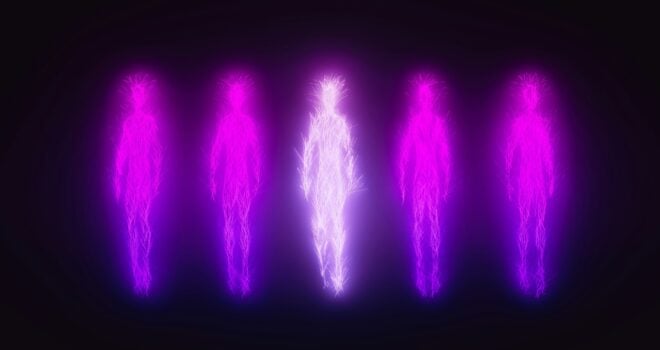Most people think of “transhumanism” in terms of cutting-edge technology: a pill that boosts intelligence beyond normal human parameters, a genetic tweak that enables the recipient to grow gills or turn sunlight into food, a cybernetic brain implant that replaces your smartphone, an eccentric tech mogul who wants to digitize his consciousness and live forever.
Zoltan Istvan, who ran for president in 2016 as the candidate of the Transhumanist Party, provides the following tech-centered definition in his novel The Transhumanist Wager:
Our biology severely limits us. As a species we are far from finished and therefore highly unacceptable. The transhumanist believes we should immediately work to improve ourselves via enhancing the human body and eliminating its weak points. This means ridding ourselves of flesh and bones, and upgrading to new cybernetic tissues, alloys, and other synthetic materials, including ones that make us cyborglike and robotic. It also means further merging the human brain with the microchip and the impending digital frontier. Biology is for beasts.
I think there’s more to it than that. Transhumanism, as a philosophy (or even a theology), was not invented ex nihilo in response to technological advancements. It would be more accurate to say that much of modern technology, along with its goals and future trajectory, is the product of transhumanist thinking. For centuries, we have been preparing the philosophical ground for an all-out assault on our common humanity.
A complete historical genealogy of transhumanism could easily run to several volumes, but for our purposes it will suffice to highlight one quote that illustrates key elements of the transhumanist ideology.
The quote comes from French philosopher Jean-Paul Sartre’s 1946 essay “Existentialism Is a Humanism“:
One cannot suppose that a man would produce a paper-knife without knowing what it was for. Let us say, then, of the paper-knife that its essence—that is to say the sum of the formulae and the qualities which made its production and its definition possible—precedes its existence . . . [If] God does not exist there is at least one being whose existence comes before its essence, a being which exists before it can be defined by any conception of it. That being is man.
You, dear reader—Sartre insists—are not a pocketknife. You were not designed for any particular end. You decide what it means to be a good human being. You decide what it means to be a human being at all. And as transhumanist technologies proliferate, the options become nearly limitless.
It’s unlikely that Sartre envisioned virtual immortals, cyborg supersoldiers, or vat-grown designer babies, but his ideas (and those of his intellectual predecessors like Hume and Nietzsche) played an important role in demolishing the barriers that made such innovations morally unthinkable. All that remained was to make them technically possible.
Enter Julian Huxley, who argued in a 1957 essay titled simply “Transhumanism” that, due to increases in scientific understanding, “man had been suddenly appointed managing director of the biggest business of all, the business of evolution—appointed without being asked if he wanted it, and without proper warning and preparation.”
Twenty-five years earlier, Julian’s brother Aldous had shown the world what this transhuman future might look like. His novel Brave New World has it all: industrial gestation facilities, genetically modified subhumans bred for drudgery, universal birth control that reduces sex to mere recreation, the widespread use of neuropharmaceuticals to assuage feelings of alienation, the elimination of “all the physiological stigmata of old age,” and even an early hint of immersive virtual reality (with “feelies” replacing movies).
The transhumanist movement today is a series of footnotes on Brave New World. The various declarations and manifestos on the website of the nonprofit Humanity+ mention “life extension therapies,” “reproductive choice technologies,” “whole brain emulation” (i.e. uploading consciousness), and “alternative options for perceptual, cognitive, and physical bodies.”
The first line of the Transhumanist Manifesto sums up all of these priorities as what they are, namely a rejection of natural law and an assertion of total human autonomy: “I am the architect of my existence. My life reflects my vision and represents my values. It conveys the very essence of my being—coalescing imagination and reason, challenging all limits.”
It is easy to dismiss self-described transhumanists as irrelevant eccentrics, but most modern people share their basic presuppositions. For proof, look no further than former Supreme Court Justice Anthony Kennedy’s opinion in Planned Parenthood v. Casey (1992), in which he declared that “at the heart of liberty is the right to define one’s own concept of existence, of meaning, of the universe, and of the mystery of human life.”
This is a profoundly Luciferian project, and indeed I would argue that transhumanism really began in the Garden of Eden, with the serpent’s promise that “ye shall be as gods.” The serpent wasn’t lying, per se. God always intended for humanity to become “partakers of the divine nature.” The deception lay not in the promise that we could become gods, but that we could achieve that divinization (or theosis) apart from our Creator.
Adam and Eve chose to grasp at transcendence on their own terms. Now, as technology increases our ability to pursue our self-deification apart from God, I can only conclude that the evil one’s plan to lure humanity to its own destruction is nearing some sort of climax.
Thankfully, there is another transhumanism on offer. The term itself wasn’t actually coined by Julian Huxley but by the medieval Catholic poet Dante Aligheri. As he is carried into Heaven to be united with “the Love that moves the sun and other stars,” the pilgrim narrator of the Divine Comedy admits his inability to trasumanar significar per verba (roughly “put into words what it means to be transhumanized”).
T.S. Eliot then beat out Julian Huxley by almost a decade, becoming perhaps the first prominent English writer to use the term in an original work. In his play The Cocktail Party, the angelic being Reilly tells another angel about the hard road to salvation that awaits a troubled woman named Celia:
You and I don’t know the process by which the human is
Transhumanized: what do we know
Of the kind of suffering they must undergo
On the way of illumination
The instrument of Celia’s transhumanization is not a pill or a surgical procedure or a cybernetic implant. It is a cross. She joins an order of nuns and serves as a nurse in a primitive, plague-stricken village on a remote Pacific island. The natives lash out against the sisters, crucify Celia, and leave her body to be eaten by ants. She suffers, Reilly notes, not only “fear and pain and loathing,” but also the “reluctance of the body to become a thing.” In Celia’s final hours, her physical humanity became a brutal, undeniable reality. Her death (like all human death and limitation) would be an affront to a transhumanist. Reilly does not hesitate to declare it a “triumph.”
To be transhumanized (in the Dante-Eliot sense of the word), one must first live and suffer as a human. It is only through the humanity we share with Christ that we come to reign with Him in glory.
Editor’s Note: For more on transhumanism, check out this author’s new book, The Transhumanist Temptation: How Technology and Ideology Are Reshaping Humanity—And How to Resist, available from Sophia Institute Press.
Photo by Marek Piwnicki on Unsplash















